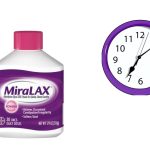Why Is MiraLAX Not Working After 3 Days?

Having fewer than three bowel movements a week is, technically, the definition of constipation. However, how often you “go” varies widely from person to person. Some people have bowel movements several times a day while others have them only one to two times a week. Whatever your bowel movement pattern is, it’s unique and normal for you – as long as you don’t stray too far from your pattern.
Regardless of your bowel pattern, one fact is certain: the longer you go before you “go,” the more difficult it becomes for stool/poop to pass. Other key features that usually define constipation include:
- Your stools are dry and hard.
- Your bowel movement is painful and stools are difficult to pass.
- You have a feeling that you have not fully emptied your bowels.
Constipation can happen for many reasons, such as when stool passes through the colon too slowly. The slower the food moves through the digestive tract, the more water the colon will absorb and the harder the feces will be. A person who poops fewer than 3 times per week may have constipation.
What is MiraLAX?
MiraLAX is a popular, FDA-approved over-the-counter laxative. MiraLAX contains polyethylene glycol 3350, an osmotic laxative. It works by attracting water in the colon, which softens stools and makes them easier to pass.
MiraLAX is tasteless, so feel free to add it to your favorite beverage without messing up the flavor. Some examples of drinks to mix it with include water, juice, soda, coffee, or tea. For people who have food restrictions, MiraLAX is also sugar-free, gluten-free, and preservative-free. Most people will have a bowel movement 1 to 3 days after they take MiraLAX. One study of its effectiveness focused on people who had fewer than two bowel movements per week. MiraLAX increased their number of bowel movements to 4.5 per week, compared to 2.7 per week in people taking a placebo.
Another study found that 52 percent of people with chronic constipation were successfully treated with MiraLAX.
What happens if MiraLAX does not work after 3 days?
If your constipation has not improved after taking MiraLAX for 3 days, speak to your doctor. MiraLAX can cause some serious health issues. This risk may be even higher for certain groups. MiraLAX can cause complete or partial blockage of intestines. Stop taking MiraLAX and call your provider if you have rectal bleeding (from your anus) or cannot have a bowel movement after taking MiraLAX. These could be signs of a more serious problem.
Before you start taking MiraLAX, speak with your provider first if you have stomach pain, nausea, or vomiting or if you’ve noticed sudden changes in your stool for more than 2 weeks. MiraLAX may not be the best medication for you, and your provider can provide MiraLAX alternatives and make sure there’s not a more serious problem going on.
What are the side effects of MiraLAX?
MiraLAX can cause mild or serious side effects. The following list contains some of the key side effects that may occur while taking MiraLAX. This list does not include all possible side effects.
For more information on the possible side effects of MiraLAX, or tips on how to deal with a troubling side effect, talk with your doctor or pharmacist.
More common side effects
The more common side effects of MiraLAX include:
• diarrhea or loose stools
• gas (flatulence)
• nausea
• stomach pain
• bloating
These side effects may go away within a few days or a couple of weeks. If they’re more severe or don’t go away, talk to your doctor or pharmacist.
Serious side effects
Call your doctor right away if you have serious side effects. Call 911 if your symptoms feel life-threatening or if you think you’re having a medical emergency. Serious side effects and their symptoms can include the following:
• Dehydration. Diarrhea caused by MiraLAX can cause fluid loss and dehydration. Seniors have a higher risk of diarrhea and dehydration. Symptoms of dehydration include:
o thirst
o fatigue
o dizziness
o confusion
o dry mouth
o irritability
o no tears when crying (in children)
o no wet diapers for several hours (in children)
• Allergic reactions. Although not common, some people can have an allergic reaction to MiraLAX. In rare cases, allergic reactions can be severe and include anaphylaxis. Symptoms of an allergic reaction can include:
o rash
o itchy skin
o runny nose
o trouble breathing
o swollen lips, tongue, or throat





